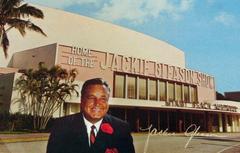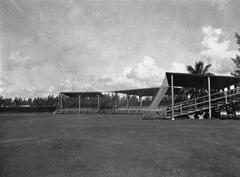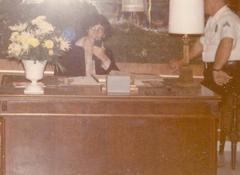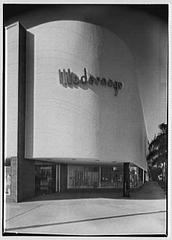
Cuban Hebrew Congregation Miami Beach: Visiting Hours, Tickets, and Historical Significance
Date: 04/07/2025
Introduction
Temple Beth Shmuel, better known as the Cuban Hebrew Congregation, stands as a pillar of resilience, faith, and cultural identity for the Cuban-Jewish community in Miami Beach. Founded in 1961 by Jewish refugees escaping the upheaval of the Cuban Revolution, this unique synagogue is not only a spiritual sanctuary but also a vibrant hub for the preservation and celebration of Cuban-Jewish heritage. Renowned for its striking Modernist architecture and rich community programming, Temple Beth Shmuel invites visitors to experience the intersection of Jewish tradition and Cuban cultural flair in the heart of Miami Beach (Cuban Research Institute; Miami Living Magazine; JTA).
Historical Overview
Founding and Early Years
The Cuban Hebrew Congregation was established in 1961 by Jews fleeing Cuba after Fidel Castro’s rise to power. These refugees, predominantly Ashkenazi and Sephardic Jews whose families had previously migrated from Europe to Cuba, sought to preserve their religious and cultural practices amidst the challenges of resettlement. Early gatherings were held in homes and rented spaces until the congregation acquired its current property at 1700 Michigan Avenue in 1975, naming it Temple Beth Shmuel in honor of community leader Samuel Scheck (Cuban Research Institute).
Growth and Community Role
Throughout the 1970s and 1980s, the congregation expanded its mission beyond religious services, introducing cultural events, language classes, youth programs, and support networks for new immigrants. It quickly became a cornerstone institution for Cuban Jews adjusting to life in the United States, blending Jewish ritual with Cuban traditions such as music and cuisine.
Architectural and Artistic Significance
Temple Beth Shmuel’s architectural design, completed in the late 1970s and further developed in 1986, is inspired by Modernist forms and organic motifs reminiscent of Antoni Gaudí. Key features include freeform stucco shapes, sand-colored finishes, and a striking blue porcelain tile roof that evokes the Caribbean Sea (SKL Architect; Saving Places). The sanctuary’s signature stained-glass windows—designed by Inge Pape Trampler—depict the Twelve Tribes of Israel, while Mexican artist Naomi Siegman’s candelabras flank the bimah. The landscaped courtyard, with six royal palm trees symbolizing Cuba’s six provinces, offers a tranquil gathering space and connects the main building to auxiliary facilities.
Visitor Information
Visiting Hours and Admission
- Address: 1700 Michigan Avenue, Miami Beach, FL 33139
- Regular Hours: Monday–Friday, 9:00 AM to 5:00 PM; Saturdays, 10:00 AM to 2:00 PM (by appointment on weekends and during holidays).
- Admission: Free for self-guided visits. Donations are welcomed to support community programs and preservation (A Better Place).
Guided Tours and Special Events
- Guided Tours: Available by appointment and during select cultural events. Tours highlight the synagogue’s art, architecture, and Cuban-Jewish history.
- Events: The synagogue regularly hosts concerts, lectures, art exhibitions, and cultural festivals, such as zarzuela performances and the Cuban Jewish Festival (Florida Grand Opera).
- Languages: Services and tours are offered in English, Hebrew, and Spanish.
- Accessibility: The building is fully wheelchair accessible.
For up-to-date schedules, contact the synagogue at 305-534-7213, or visit the official website.
Community and Cultural Life
Religious Services
Temple Beth Shmuel is affiliated with the Conservative movement. It offers regular Shabbat and holiday services in multiple languages, integrating Cuban musical and cultural elements into traditional Jewish liturgy (Jewish Miami). During major Jewish festivals, the synagogue becomes a gathering point for the broader community.
Education and Intergenerational Programs
Educational initiatives include a Montessori school, adult learning, Torah study, and guest lectures that celebrate Cuban-Jewish heritage (Wikipedia). Youth and family programming ensures the transmission of cultural identity to future generations.
Social and Cultural Activities
The congregation also functions as a social nucleus, continuing the legacy of the “Circulo Cubano-Hebreo de Miami” with communal meals, Spanish-language events, and cultural celebrations. The social hall and ballroom host public events, private functions, and community gatherings, fostering inclusivity and cultural continuity.
Architectural Highlights
- Stained Glass Windows: Depict the Twelve Tribes of Israel, illuminating the sanctuary with vibrant color and symbolism (Everything Explained Today).
- Candelabras and Liturgical Art: Modern pieces by Naomi Siegman blend Latin American artistry with Jewish ritual.
- Courtyard: Six royal palm trees symbolize the congregation’s Cuban roots and provide a serene setting for gatherings.
- Social Hall and Ballroom: Flexible space for up to 800 people, equipped with modern lighting and sound for celebrations and performances.


Nearby Attractions
Temple Beth Shmuel’s central location allows visitors to explore other Miami Beach historical sites such as:
- Miami Beach Botanical Garden
- Jewish Museum of Florida-FIU
- Miami Beach Architectural District
Frequently Asked Questions (FAQ)
Q: What are the synagogue’s visiting hours?
A: Monday–Friday, 9:00 AM–5:00 PM; Saturday by appointment; closed on major Jewish holidays.
Q: Is admission free?
A: Yes; donations are appreciated.
Q: Are guided tours available?
A: Yes, by appointment or during special events.
Q: Is the synagogue accessible?
A: Fully wheelchair accessible.
Q: Can visitors attend services?
A: Yes, visitors are welcome. Check the calendar for service times.
Q: Are special events ticketed?
A: Some concerts and cultural events require tickets; check event listings.
Q: What languages are services conducted in?
A: Services and tours are offered in English, Hebrew, and Spanish.
Preservation, Legacy, and Future Outlook
Temple Beth Shmuel is committed to preserving Cuban-Jewish heritage through:
- Archival Projects: Oral histories, documents, and artifacts chronicling the community’s journey from Cuba to Miami.
- Collaborations: Partnerships with institutions like the Jewish Museum of Florida-FIU to support exhibitions and educational initiatives (Jewish Museum of Florida-FIU).
- Interfaith and Civic Engagement: Active involvement in Miami’s broader Jewish and Cuban American landscape.
Despite declining membership, the congregation remains focused on legacy, inclusivity, and adaptation—embracing technological advances and expanding its reach to new generations and Latin American communities (Times of Israel).
Essential Travel Tips
- Getting There: Easily accessible by public transit and private vehicle. Parking available on-site or nearby.
- Dress Code: Modest attire, particularly in the sanctuary.
- Photography: Permitted in public areas; please be respectful during services.
- Best Times to Visit: Weekdays are generally less crowded.
Plan Your Visit
Temple Beth Shmuel is more than a synagogue—it is a living testament to the creativity, resilience, and enduring spirit of Miami’s Cuban-Jewish community. Whether you are drawn by architecture, history, or cultural curiosity, a visit promises inspiration and insight into one of Miami Beach’s most distinguished historical sites.
For the latest visitor information and event updates, visit the official website or connect via social media. Download the Audiala app for guided tours and audio experiences at Temple Beth Shmuel and other Miami Beach landmarks.
Further Reading and Resources
- Cuban Research Institute
- Miami Living Magazine
- JTA
- Times of Israel
- Saving Places
- SKL Architect
- Unpacked Media
- Florida Grand Opera
- Jewish Miami
- Jewish Museum of Florida-FIU
- Everything Explained Today
- Synagogues 360






